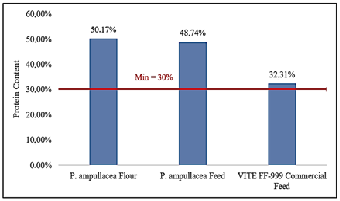Application of Rice Field Snails (Pila ampullacea) Extract as an Alternative Substitute for Protein Sources in Export-Quality Catfish Feed (Clarias sp.)
Abstract
The freshwater fishery commodity that ranks at the top in total production in Indonesia, and its high domestic consumption, is catfish (Clarias sp.). One of the efforts to provide alternative feeds is by using rice field snails (Pila ampullacea) due to their high protein content. This study aims to determine the content of P. ampullacea feed and its application as an alternative protein source in export-quality Clarias sp. The feed was prepared by combining P.ampullacea flour, rice bran, and corn flour in a ratio of 3:1:1. Analysis of water content was conducted using the weight reduction method, ash content using the ashing method, protein content using the Kjeldahl method, and fat content using the soxhletation method. The analysis results showed that P. ampullacea had water content of 7.97%, ash content of 10.36%, protein content of 50.17%, and fat content of 4.16%. Meanwhile, the P.ampullacea feed had water content of 10.49%, ash content of 8.26%, protein content of 48.74%, and fat content of 3.6%. The results indicated that the application of P.ampullacea to Clarias sp. led to an increase in protein and fat content every week, the levels found in the commercial feed used.
Downloads

Copyright (c) 2023 Syahruddin Kasim, Yusafir Hala, Lulu Sri Rahayu

This work is licensed under a Creative Commons Attribution-NonCommercial-NoDerivatives 4.0 International License.
Authors who publish with this journal agree to the following terms:
- Copyright on any article is retained by the author(s).
- The author grants the journal, the right of first publication with the work simultaneously licensed under a Creative Commons Attribution License that allows others to share the work with an acknowledgment of the work’s authorship and initial publication in this journal.
- Authors are able to enter into separate, additional contractual arrangements for the non-exclusive distribution of the journal’s published version of the work (e.g., post it to an institutional repository or publish it in a book), with an acknowledgment of its initial publication in this journal.
- Authors are permitted and encouraged to post their work online (e.g., in institutional repositories or on their website) prior to and during the submission process, as it can lead to productive exchanges, as well as earlier and greater citation of published work.
- The article and any associated published material is distributed under the Creative Commons Attribution-NonCommercial-NoDerivatives 4.0 International License.





_copy1.png)










